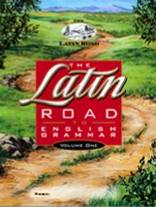Forget direct comparisons to other Latin programs; The Latin Road to English Grammar is really different. It combines instruction in English grammar with Latin, eliminating the need to use anything else for those subjects in most situations. The author states that students as young as fourth grade have successfully worked through Volume I, although it will be more appropriate for most students who are in fifth grade or beyond. It should also work well with students beginning at junior or senior high levels.
Some of author Barbara Beers' experience comes from teaching The Writing Road to Reading, so we find that same methodology incorporated as children compile their own notebooks of everything they are learning. The student text comes in a binder. Students create ten sections in their binders for vocabulary, pronunciation, definitions, grammar, cases/declensions, conjugations, text work (answers to text questions/exercises), worksheets, word study, and tests. Even though information is presented in the student text, children record it in their notebooks to enhance learning and provide a ready-reference tool. The student binder for Volume I also includes a Latin Comprehensive Reference Guide that shows grammar tables for all that will be covered over the three years, with color coding to indicate which concepts are covered in which volume.
New concepts come at a shotgun pace in this program. For example, in Chapter 1, children briefly review the eight principal parts of speech (nine if you separate articles from adjectives). In the next day's lesson, they are working with syntax, covering subjects, predicates, direct and indirect objects, linking verbs, predicate adjectives, and predicate nominatives. Latin syntax structures are presented immediately following the English syntax. While much of this is introduced superficially—as material for a student to copy into his notebook for now—it accumulates quickly. I think that most students will be more successful in this program if they have already studied basic grammar. Treating the English grammar coverage here as review and application seems the most practical. This means that you might use one grammar text at upper elementary or a higher level before beginning this course. For students in grades three through six, you might also want to check out Schola Publication's The Bridge to the Latin Road, which serves as a one-year introduction to prepare both teacher and student with the basics of English grammar and beginning study of Latin roots. (The Bridge course has a streaming option available.)
The course includes plans for 140 daily lessons. If you take extra time where needed, it will definitely take a year to get through Volume I.
English grammar is usually taught simultaneously with the Latin as structural similarities are noted. This method is very efficient. It is also a positive motivator for students to see that this grammar knowledge does serve an immediate purpose.
Coverage of English grammar in Volume I includes parts of speech, syntax, gender, number, voice, mood, tense, person, principal parts of verbs (stressed more in Latin than in English), types of sentences, prefixes, adjective/noun agreement, and subject/verb agreement.
Latin instruction encompasses all of the above plus case, stems, distinctions in ablative case usage, enclitics, and word particles while teaching through the second declension nouns and first conjugation verbs (six tenses).
Volume II continues with all of the above, working through the third declension nouns and adjectives, pronouns, demonstrative adjectives, and third conjugation verbs. Students continue to drill and build upon all they have learned in the first volume.
The third volume completes Latin coverage equivalent to about two years of standard courses, so the progression on Latin is slower here. (This is certainly very appropriate for pre-high school students.) When coupled with the in-depth coverage of English grammar, the program is moving at a pace that should be appropriate for most students, but possibly too quick for some.
The program for each level comes as a complete set with everything you need for one teacher and one student: a teacher's binder, access to teacher training videos, CDs (for correct pronunciation of all forms, vocabulary, and readings), flashcards, and a student package, You can purchase additional student packages separately. The complete student package for each level includes the textbook and binder; blue, pink, and yellow notebook paper for constructing that year's notebook pages to coordinate with vocabulary cards; binder tabs; five colored ink pens; and a Reference Guide.
The teacher's binder has daily lesson plans and teaching directions, answer keys, charts to be used with lesson presentation (and posted for reference), and reproducible tests and map. On the CDs, Barbara pronounces the Latin sounds and the words pertinent to the various lessons using ecclesiastical or church Latin pronunciation.
The flashcards are printed on heavy card stock and are color-coded to identify parts of speech as well as the gender of nouns. (These cards are great for drilling declension and conjugation endings as well as vocabulary.)
The first half of each student book is the text, which has instruction and exercises. (No writing in the book in this section.) Reading practice material in Latin, such as The Lord's Prayer, the Pledge of Allegiance, and the song, "O Come All Ye Faithful," is incorporated into the student texts. Latin/English and English/Latin glossaries are in the middle. Perforated, tear-out worksheets comprise the last half of the book. You can reuse the text part of a student book, purchasing only replacement worksheets for subsequent students to save money.
The program is designed to be taught rather than used for independent study. Some lesson preparation is necessary. According to the author, those without Latin background can teach this course, but I suspect that those without a solid English grammar background will have difficulty. Parents who have an adequate grammar background, as well as the time to teach this course properly, should find it an excellent tool for building a thorough, solid foundation in both English grammar and Latin.








